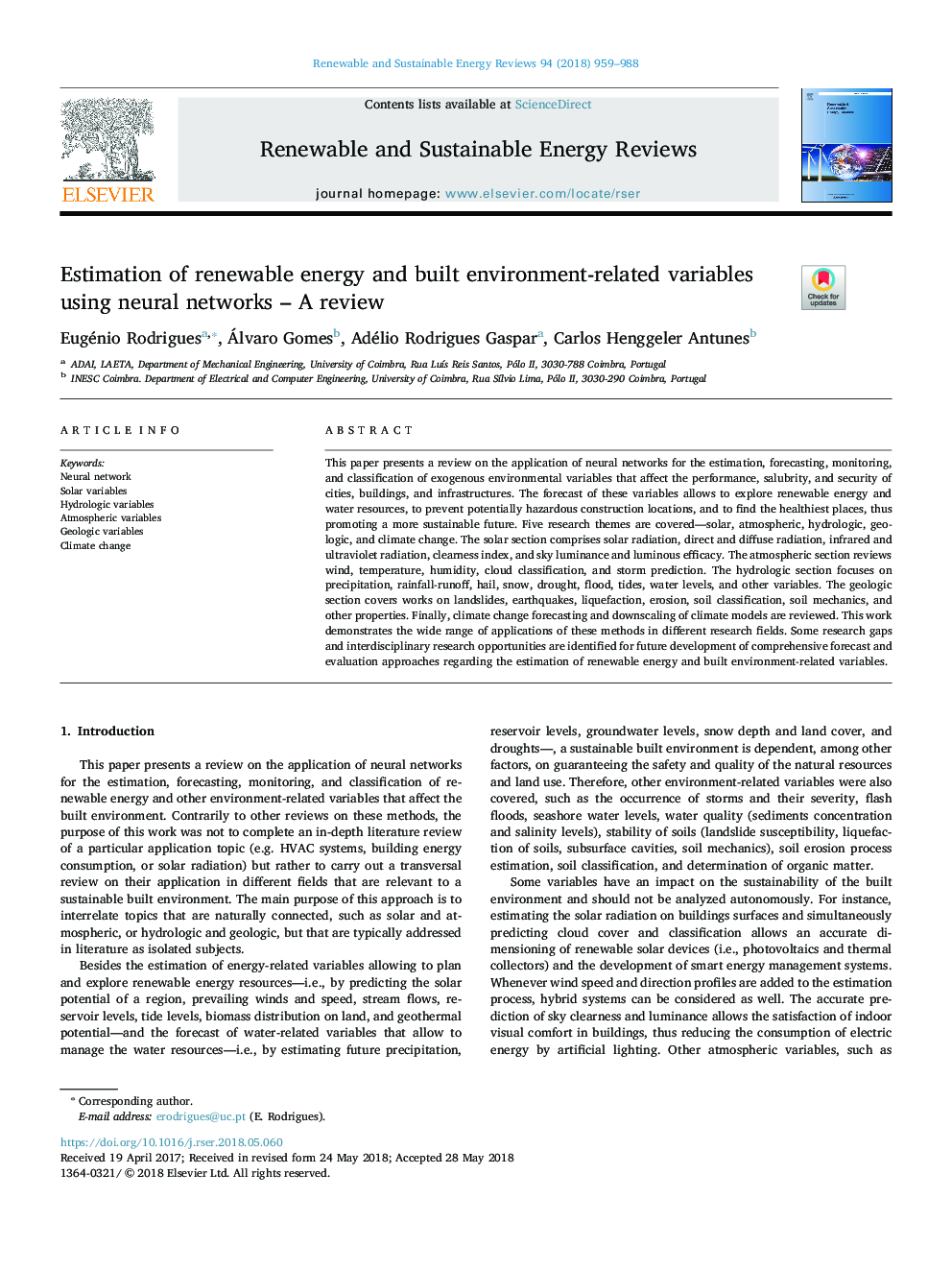| کد مقاله | کد نشریه | سال انتشار | مقاله انگلیسی | نسخه تمام متن |
|---|---|---|---|---|
| 8110581 | 1522290 | 2018 | 30 صفحه PDF | دانلود رایگان |
عنوان انگلیسی مقاله ISI
Estimation of renewable energy and built environment-related variables using neural networks - A review
ترجمه فارسی عنوان
برآورد انرژی تجدیدپذیر و متغیرهای مرتبط با محیط زیست با استفاده از شبکه های عصبی - بررسی
دانلود مقاله + سفارش ترجمه
دانلود مقاله ISI انگلیسی
رایگان برای ایرانیان
کلمات کلیدی
شبکه عصبی، متغیرهای خورشیدی، متغیرهای هیدرولوژیکی، متغیرهای اتمسفر، متغیرهای ژئولوژیک، تغییر آب و هوا،
ترجمه چکیده
این مقاله بررسی کاربرد شبکه های عصبی برای برآورد، پیش بینی، نظارت و طبقه بندی متغیرهای محیطی خارجی که بر عملکرد، سالمندی و امنیت شهرها، ساختمان ها و زیرساخت ها تأثیر می گذارد، ارائه شده است. پیش بینی این متغیرها امکان بررسی انرژی های تجدید پذیر و منابع آب را برای جلوگیری از موقعیت های ساخت و ساز بالقوه خطرناک و یافتن مکان های سالم تر فراهم می کند. پنج موضوع تحقیقاتی شامل خورشید، جوی، هیدرولوژیکی، زمین شناسی و تغییرات آب و هوایی است. بخش خورشیدی شامل تابش خورشید، تابش مستقیم و پخش شده، اشعه مادون قرمز و اشعه ماوراء بنفش، شاخص روشنایی، و روشنایی آسمان و اثر نورانی است. بخش جوی بررسی باد، دما، رطوبت، طبقه بندی ابر و پیش بینی طوفان. بخش هیدرولوژیکی بر بارش، بارش باران، روان، گره، برف، خشکسالی، سیل، جزر و مد، سطح آب و سایر متغیرها تمرکز دارد. بخش زمین شناسی کارهایی را در زمره لغزش ها، زمین لرزه ها، مایع سازی، فرسایش، طبقه بندی خاک، مکانیک خاک و سایر ویژگی ها انجام می دهد. در نهایت پیش بینی و تغییرات اقلیمی مدل های آب و هوایی بررسی می شود. این کار طیف وسیعی از برنامه های کاربردی این روش ها را در زمینه های مختلف تحقیق نشان می دهد. برخی از شکاف های تحقیق و فرصت های تحقیق بین رشته ای برای توسعه آینده روش های پیش بینی و ارزیابی جامع در زمینه برآورد انرژی تجدید پذیر و متغیرهای مرتبط با محیط زیست شناسایی شده اند.
موضوعات مرتبط
مهندسی و علوم پایه
مهندسی انرژی
انرژی های تجدید پذیر، توسعه پایدار و محیط زیست
چکیده انگلیسی
This paper presents a review on the application of neural networks for the estimation, forecasting, monitoring, and classification of exogenous environmental variables that affect the performance, salubrity, and security of cities, buildings, and infrastructures. The forecast of these variables allows to explore renewable energy and water resources, to prevent potentially hazardous construction locations, and to find the healthiest places, thus promoting a more sustainable future. Five research themes are covered-solar, atmospheric, hydrologic, geologic, and climate change. The solar section comprises solar radiation, direct and diffuse radiation, infrared and ultraviolet radiation, clearness index, and sky luminance and luminous efficacy. The atmospheric section reviews wind, temperature, humidity, cloud classification, and storm prediction. The hydrologic section focuses on precipitation, rainfall-runoff, hail, snow, drought, flood, tides, water levels, and other variables. The geologic section covers works on landslides, earthquakes, liquefaction, erosion, soil classification, soil mechanics, and other properties. Finally, climate change forecasting and downscaling of climate models are reviewed. This work demonstrates the wide range of applications of these methods in different research fields. Some research gaps and interdisciplinary research opportunities are identified for future development of comprehensive forecast and evaluation approaches regarding the estimation of renewable energy and built environment-related variables.
ناشر
Database: Elsevier - ScienceDirect (ساینس دایرکت)
Journal: Renewable and Sustainable Energy Reviews - Volume 94, October 2018, Pages 959-988
Journal: Renewable and Sustainable Energy Reviews - Volume 94, October 2018, Pages 959-988
نویسندگان
Eugénio Rodrigues, Álvaro Gomes, Adélio Rodrigues Gaspar, Carlos Henggeler Antunes,
